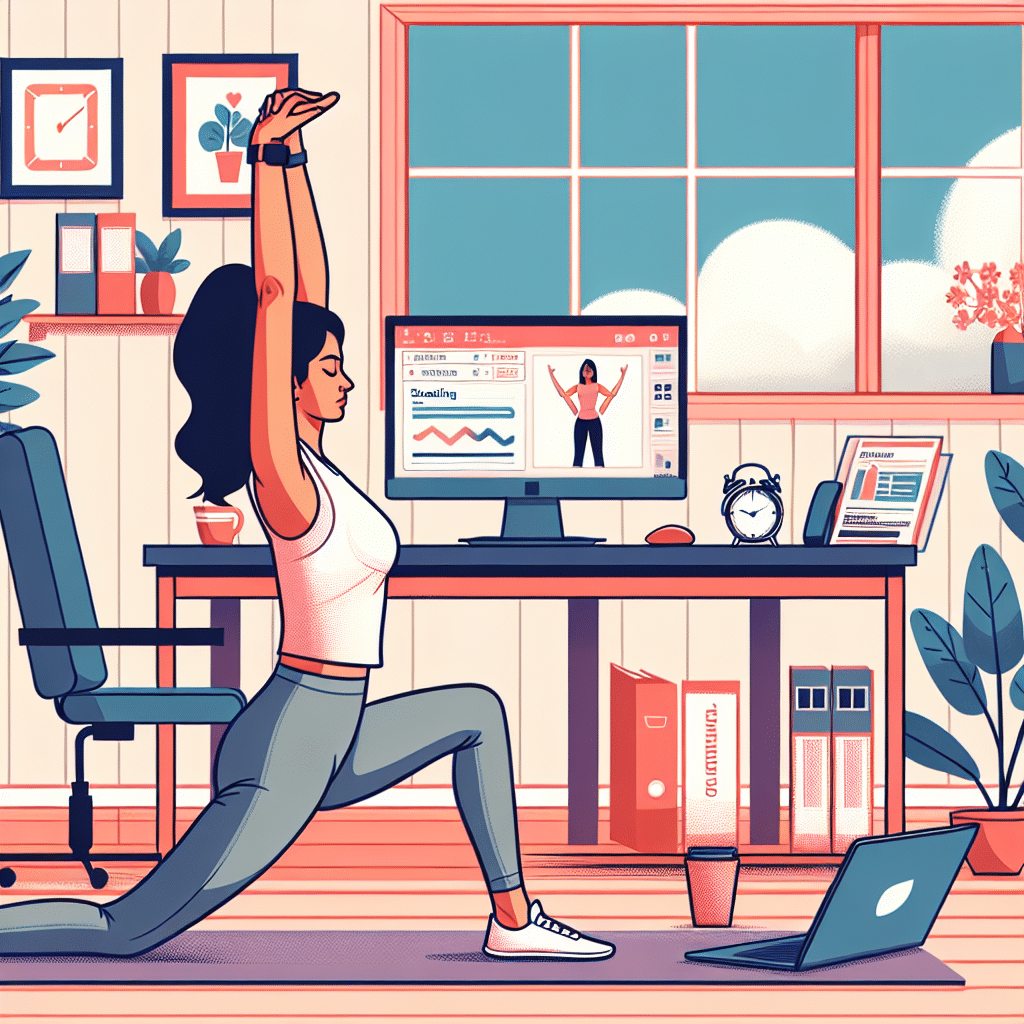Understanding Remote Work Strain
Remote work has become an essential part of modern life, yet it often leads to physical strain due to prolonged sitting, poor posture, and insufficient movement. The lack of ergonomic setups in home offices can exacerbate discomfort and contribute to long-term health issues. Effective stretching routines can play a pivotal role in counteracting these challenges, promoting overall well-being and enhancing productivity. This article explores a variety of routines designed specifically to combat remote work strain.
Benefits of Stretching in Remote Work
Incorporating stretching into your daily routine can yield numerous benefits:
- Improved Flexibility: Regular stretching helps maintain flexibility, reducing tension and preventing injuries.
- Posture Correction: Certain stretches target specific muscles that contribute to poor posture, promoting spinal alignment.
- Increased Circulation: Stretching enhances blood flow, which can alleviate feelings of fatigue and lethargy.
- Stress Relief: Stretching can decrease muscle tension and provide mental relief, fostering a sense of calm.
- Boosted Productivity: Taking brief stretch breaks can increase alertness and focus, ultimately leading to enhanced performance.
Key Stretches for Remote Workers
1. Neck Stretches
Purpose: Alleviates tension from long hours spent looking at screens.
Routine:
- Neck Tilt: Sit upright, slowly tilt your head to one side, bringing your ear towards your shoulder. Hold for 15-30 seconds. Repeat on the opposite side.
- Neck Rotation: Gently turn your head to the right, holding for 15-30 seconds. Alternate to the left side.
2. Shoulder Stretches
Purpose: Reduces tightness in the shoulder muscles caused by hunching over desks.
Routine:
- Shoulder Shrugs: Raise your shoulders towards your ears, hold for a second, then relax. Repeat 10 times.
- Cross-Body Shoulder Stretch: Bring one arm across your body, holding it with the opposite arm. Maintain for 15-30 seconds, then switch sides.
3. Upper Back Stretches
Purpose: Targets the upper back muscles, mitigating the strain from poor posture.
Routine:
- Cat-Cow Stretch: Start on all fours, arch your back upward (cat), then dip it down while lifting your head (cow). Perform 5-10 cycles.
- Seated Twist: While seated, place one hand behind you and twist to look over your shoulder. Hold for 15-30 seconds, then repeat on the other side.
4. Chest Stretches
Purpose: Opens up the chest, countering the rounded posture from sitting.
Routine:
- Doorway Stretch: Stand in a doorway with forearms resting against the frame; gently lean forward to feel a stretch in the chest. Hold for 15-30 seconds.
- Arm Circles: Extend arms out to the sides, making small circles for 30 seconds, gradually increasing the size.
5. Hip Flexor Stretches
Purpose: Alleviates tightness in the hip flexors from prolonged sitting.
Routine:
- Lunging Hip Flexor Stretch: Step one foot forward into a lunge, keeping the opposite knee on the ground. Lean forward gently, feeling the stretch in the hip flexor of the back leg. Hold for 15-30 seconds on each side.
- Pigeon Pose: Start in a tabletop position, bring one knee forward and extend the opposite leg back. Keep your hips square to the front; hold for 15-30 seconds and switch sides.
6. Lower Back Stretches
Purpose: Eases discomfort in the lower back area from extended sitting.
Routine:
- Seated Forward Bend: While seated, extend your legs and reach for your toes. Hold for 15-30 seconds.
- Child’s Pose: Kneel, sit back on your heels, and stretch your arms forward on the floor. Hold for 30 seconds to a minute.
7. Leg Stretches
Purpose: Improves circulation in the legs and alleviates muscle tightness.
Routine:
- Calf Stretch: Stand facing a wall, place one foot behind the other, and push the back heel down. Hold for 15-30 seconds on each side.
- Quadriceps Stretch: Stand and grab one ankle to pull it towards your buttocks. Hold onto support if necessary. Hold for 15-30 seconds and switch sides.
Integrating Stretching into Your Day
To maximize the benefits of these routines, consider the following strategies for integration:
- Establish a Schedule: Dedicate specific times for stretching during your workday, such as every hour or before/after meetings.
- Set Reminders: Use alarms or apps to remind you to take stretching breaks.
- Combine with Deep Breathing: Pair stretching with deep breathing exercises to enhance relaxation and mindfulness.
- Use Visual Cues: Post reminders in your workspace to encourage frequent stretching.
Tips for Effective Stretching
- Don’t Rush: Take your time with each stretch, focusing on form and controlled breathing.
- Listen to Your Body: Be mindful of any pain or discomfort during stretches. Modify or skip stretches as needed.
- Stay Hydrated: Maintain fluid intake to support muscle function.
- Perform Dynamic Stretches: Incorporate dynamic stretches as a warm-up if you engage in more vigorous physical activity post-work.
Conclusion
Engaging in effective stretching routines tailored for remote work can greatly improve your physical comfort, enhance your productivity, and promote overall well-being. By routinely incorporating these stretches into your workday, you can mitigate the negative effects of a sedentary lifestyle, ultimately supporting your career and health. Prioritizing these short, effective exercises can transform your remote work experience for the better.
